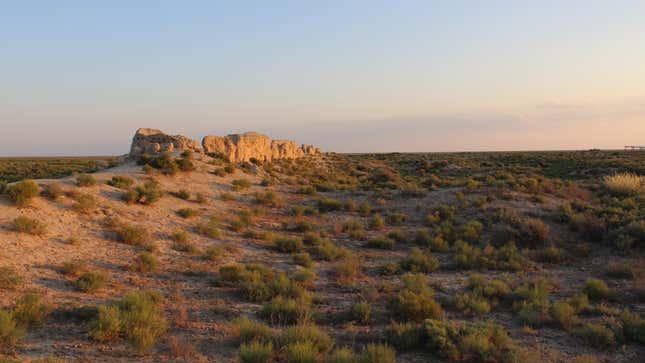
Archaeologists in Kazakhstan have discovered the well-preserved remains of a cat that died over 1,000 years ago along the Silk Road. The feline lived a tough life but was apparently cared for by pastoralists, in an unheard of practice given their nomadic lifestyles.
The nearly complete cat skeleton was found at an archaeological site within the medieval city of Dzhankent in southern Kazakhstan. An international research team, which included scientists from Martin Luther University Halle-Wittenberg (MLU), Korkyt-Ata Kyzylorda State University in Kazakhstan, and other institutions, recovered the cat’s entire skull, lower jaw, parts of its upper body, legs, and four vertebrae.
Radiocarbon dating of the cat’s femur produced a date between 775 and 940 CE. Back then, this region was inhabited by the Oghuz people, a pastoralist Turkic tribe. Dzhankent was located at a critical junction of the Silk Road—a network of trade routes within Asia and the Mediterranean region.

“The Oghuz people were a medieval Turkic people that lived in the Central Asian steppes of modern-day Mongolia, Kazakhstan, and parts of Uzbekistan and Turkmenistan in the medieval period,” wrote Ashleigh Haruda, the first author of the new study and a scientist at MLU, in an email to Gizmodo. “We know that they were nomadic and relied upon large herds of sheep, goats, cattle, and horses for their economy—similar to the ways that people had been living on the steppe for thousands of years before that.”
And they apparently owned cats, or at least a cat, according to the new paper, published today in Scientific Reports.
The cat appears to have been deliberately buried, which explains the excellent state of the skeleton. Finds like this are very rare, as scientists typically find the scattered remains of animal bones, making it difficult to piece together an animal’s life history.
At the same time, evidence of cats dating back to this place and time is sparse. The scattered evidence that does exist suggests cats were sometimes present in agricultural cities, such as modern-day Iran and Turkmenistan. As for cats living with pastoralists, scientists figured this probably didn’t happen given their mobile lifestyles and no utilitarian need for felines.
“For people who rely largely on herd animals for their survival and move around the landscape, such as pastoralists, cats were likely not all at common, or indeed, ‘useful,’” Harada told Gizmodo. “Remember, cats like to have their own territory and are not generally considered to be ideal mobile animals. Furthermore, if most of a human population’s food is on the hoof, rather than in a silo, then rodent control isn’t as necessary as it is for agricultural societies.”
But as the new research points out, this particular kitty appears to have been cared for by its nomadic owners. By performing physical, genetic, and isotopic analyses of the skeleton, Harada and her colleagues pieced together the story of this cat’s life.
DNA evidence showed it was most certainly a domesticated cat, belonging to the feral species Felis catus L. and not closely related to wild steppe cats. The age of the cat when it died couldn’t be determined, but it likely lived beyond its first year of life.
3D images and X-rays of the skeleton shows the cat suffered several broken bones but recovered from its injuries. Strangely, the cat had lost most of its teeth, so it probably couldn’t hunt or feed itself—an observation the researchers attributed to the cat being cared for by humans. And indeed, as the isotopic analysis showed, the cat had a diet unusually high in protein, as compared to other cats and dogs living during the same time period.
“All of the evidence taken together, but especially the bones, indicate that this animal suffered a lot of trauma in its life, but not only did it survive, it continued to thrive,” explained Haruda. “The most informative for us was the loss of the teeth. We could see that it had lost its canines and some of its other teeth completely and that the tooth roots had healed over. The loss of these teeth would have made it difficult for the cat to hunt successfully.”
What’s more, the extensive fractures and trauma would have made it difficult for the cat to move while the injuries healed, she said. As for the high-protein diet, this suggests the cat was not given grain mush or other waste products but was instead given meat.
“All of these things together tell us that the cat was cared for and would have had a hard time surviving on its own,” Haruda told Gizmodo.
As noted, cats would have served no functional purpose for the pastoralists. So why did the Oghuz people bother with them? As the researchers speculated in the paper, cats may have been seen as a novelty item—a kind of exotic pet.
This particular cat and possibly others could have been acquired on the Silk Road, pointing to a previously unknown item of cultural exchange between regions along the trade network. The discovery also shows that the acquisition of cats as exotica or pets happened earlier in the Central Asian steppes than is conventionally assumed. As the authors put it in their paper, the cat skeleton is “evidence for a fundamental shift in the nature of human-animal relationships” within this region.
As an interesting aside, chickens and hares were brought into Britain some 2,300 to 2,200 years ago, but not for food. Like the Dzhankent cat, chickens and hares were acquired as exotic animals. Not only that, ancient Britons worshipped these animals, as they were associated with various gods. It was only later, during the Roman period, that chickens and hares were seen as tasty meals. We don’t know if the Oghuz people revered cats in a similar way, but it would certainly be an interesting line of inquiry for scientists to pursue.